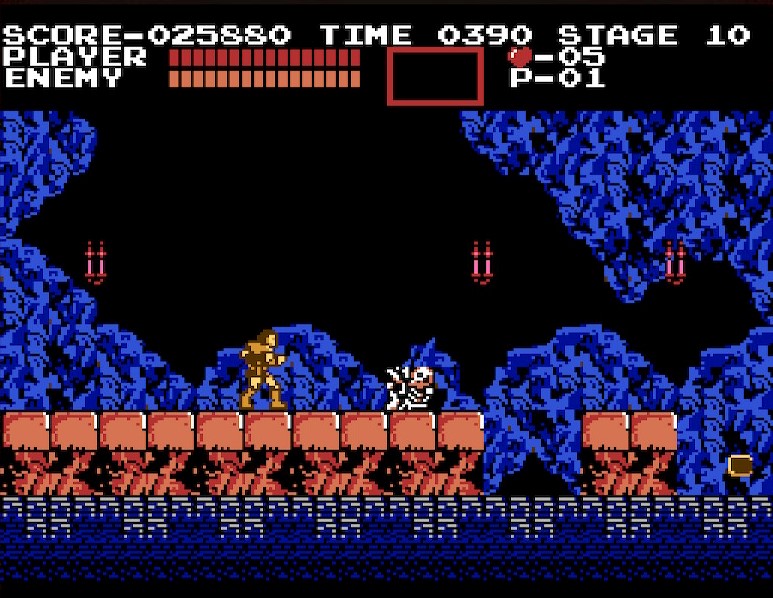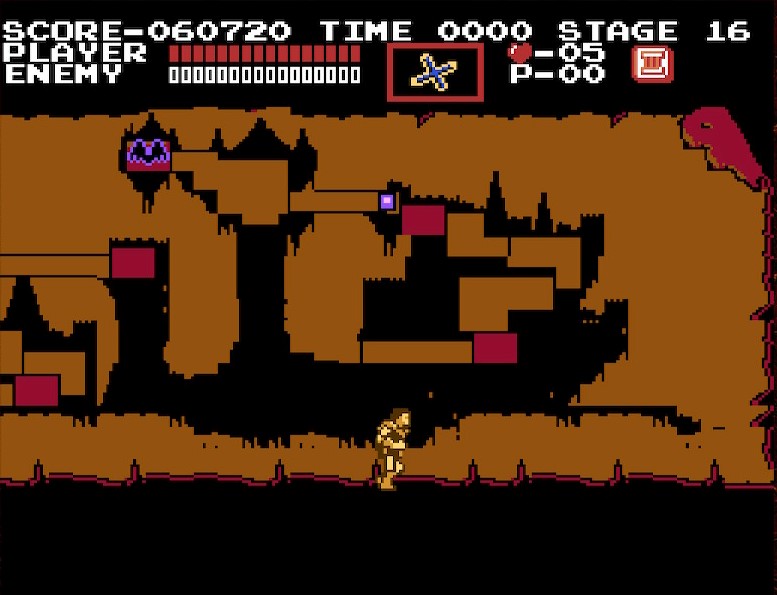The Castlevania series is a mainstay of classic Nintendo games. Strangely, despite there being four, as a kid I never saw or played any of them! So I came into the first Castlevania game fresh, and I attest that it lives up to its reputation.
Watch a video version of this review
Castlevania draws you in as soon as you turn it on. The title screen looks like a film reel, and when you start, it plays a little cinematic of the hero, Simon Belmondo, entering Dracula's castle. The music and visuals are dark and realistic, in contrast to the light, cartoony look of Super Mario. Simon has a magic whip (à la Indiana Jones), which he uses to defeat all manner of spooky monsters. Vampire Bats, Zombies, Fish Men, Skeletons, Hunchbacks, Ghosts: this game has every horror stereotype you can imagine. Every three stages Simon faces a classic horror-movie boss: Frankenstein's Monster and Igor, the Mummy, the Grim Reaper, and finally Count Dracula himself. I feel sorry for myself having missed this back in the day because it sounds like every 8-year-old boy's dream game.
Besides its horror theme, what sets Castlevania apart from other games is its selection of secondary weapons: the watch, dagger, axe, holy water (called "fire bomb" in the manual), and cross-shaped boomerang. This aspect of the game is redolent of Ghosts 'n Goblins. The watch freezes enemies for several seconds, the dagger flies across the room horizontally, the axe is powerful and travels in an arc, the holy water burns in place, damaging any enemies that walk into it, and the boomerang, well, boomerangs. At first I thought "fire bomb" was an attempt to censor religious elements, but it calls the rosary (which clears the screen of all foes) "cross," so I guess not! We should count ourselves blessed that this game saw release in America, given how paranoid Nintendo of America was about offending religious conservatives.
To use a sub-weapon, you hold ↑ while pressing B. This is a bit annoying when Mr. Belmondo is next to stairs, as he often is, since ↑ makes him ascend them. He has limited ammunition, which is replenished by collecting hearts dropped by enemies or found by whipping candlesticks. It was hard for me to get used to the hearts providing ammunition rather than replenishing the health meter, which is instead done by finding pork chops hidden in blocks! Why the walls of Dracula's castle contain fresh pork chops is beyond me, but hey, it's a game. You also find morning stars, which make your whip longer (up to twice), and bags of money that give you points. Every 30,000 points nets you an extra life.
The controls can be tricky because Simon can't change direction mid-jump, nor can he run. This feels limiting when you're used to Super Mario or Samus Aran. In addition, whenever he gets hit by an enemy, he flies backwards a little. If he's next to a ledge, as he often is, that's an instant death. This can be frustrating, so you have to take care when fighting near gaps.
Castlevania has one notable drawback: it's hard. NES hard. It starts out reasonable enough, ramps up quickly, and gets positively nasty when you reach level 13. It's filled with bouncing Hunchbacks and bone-tossing Skeletons. Level 14 introduces the hardest enemy in the game, Axe-Men, which also appear in level 15, the hardest in the game. Simon has to pass a veritable gauntlet of Axe-Men interlaced with flying Medusas (disembodied heads). The boomerang helps considerably, but it still requires practice to learn to clear this stage consistently. Then, at the end of it, you have to face an extremely difficult boss, the Grim Reaper himself! Although he merely flies around the room slowly, he shoots up to four projectiles at a time that fly back and forth across the room directly at Simon. Whenever you destroy a projectile, Death shoots another to replace it.
I watched videos of other people defeating him to learn how to do it. The trick is to defeat the Axe-Men using the boomerang, so that they or the candlesticks will drop the Double and Triple Shot power-ups. These won't drop if you are using the magic whip, and they let Simon shoot two or three of his current sub-weapon at a time. The value of obtaining the Triple Shot cannot be exaggerated, especially when facing the Grim Reaper. Throwing boomerangs all over the place lets you both clear his projectiles and defeat him.
A corollary to the game's excessive difficulty is that it uses a now-archaic system common in the 80's: sending you back levels after a Game Over. The game contains eighteen stages organized into six locations. A full-screen map shows your progress between locations. When you run out of lives, Simon returns to the first stage of that location. So, for example, when you die on level 15 (as a new player will frequently), you have to go back and beat levels 13 and 14 again. Since these are hard, you may lose one or more lives in the process. By the time you get back to the Grim Reaper, you may be on your last life with very little health, in which case he'll make quick work of you and give you only a few seconds to practice. This happened to me many times.
It got so frustrating that I used a save state to let myself practice against the Grim Reaper repeatedly. Once I finally defeated him three times in a row, I went back to level 13 and finished it properly, now that I knew how. In a way, this is "cheating" because it is not possible to get this practice on original hardware without spending hours grinding through the levels. At this point in my life that is not worth it. It's also not something I would have had the patience for as a kid. Again: NES hard.
The final three levels of the game are easier. The ultimate fight with Dracula, however, is a doozy. The game developers must have realized how hard it was because they made the uncharacteristically generous decision to let you continue immediately before the fight! As a result, you can practice against Dracula as much as you want (no save states required). I'm glad they had the wisdom to do this; if only they could have realized something that most developers hadn't figured out by 1987, namely that you should never make the player repeat levels.
Dracula's first form uses a pattern that can be mastered. Simon can always jump over his triple-fireball attack and whip him in the head. The hardest part is that he disappears and reappears after each attack, sometimes appearing right on top of Simon!
His second form looks like a mutant werewolf or something and as far as I know is not based on any movie. Now he also jumps at you, albeit slowly. Sometimes his jump goes high in the air, so Simon can walk under him. Most jumps are low, so he has to back up. If he gets cornered, Dracula's low jump can't be avoided. Fortunately, the game again shows mercy: the leftmost candlestick always drops holy water. Provided Simon has sufficient hearts, he can repeatedly stun the count with it, giving him a chance to whip him in the head safely. It's a hard fight, but I found clearing levels 13-15 much harder because you have to finish three levels on three lives, whereas when you face Dracula, you can try as many times as you like till you've mastered the patterns. As in many NES games, beating the game unlocks a more difficult "second quest." Interestingly, the stage counter keeps climbing, like in an arcade game, so you can play the game endlessly.
Unfortunately, the game barely predates battery-backed saving in NES games, whereas in Japan it was a Disk System game (and even had an easy mode!). We got the short end of the stick here. But despite the difficulty, Castlevania is a fantastic game. The visuals and music are phenomenal, top tier for the NES and made all the better by how they stand out from most titles. The dark and spooky atmosphere just works. It has nice little touches like the opening cinematic, the map between locations, and end credits that riff on classic horror actors' names (e.g., "Christopher Bee" as Dracula). Castlevania is a quintessential NES title that I strongly recommend.
Grade: A
Linked Reviews
"Although subsequent entries in the lineage have improved on the formula, Simon Belmont's legendary début remains an 8-bit classic and is well worth experiencing."
— Marcel van Duyn, Nintendo Life, 8/10
— Marcel van Duyn, Nintendo Life, 8/10
"I applaud what Konami did here: creating a game universe bringing together all the famous monsters from literature and film – an outstanding idea. It's definitely not for the faint of heart though."
— Pat Contri, Ultimate Nintendo: Guide to the NES Library, 4/5
— Pat Contri, Ultimate Nintendo: Guide to the NES Library, 4/5
"In short, this is a masterpiece, a nearly-perfect little piece of video gaming and one that deserves all the plaudits given it, even if the American version does fall on the crazy-hard side of things."
— Jeremy Parish, NES Works
— Jeremy Parish, NES Works
"It wasn't only the aesthetics that made the original Castlevania a great game. . . It was the gameplay that was at the heart of Castlevania's epic rise from unknown brand to Konami flagship."
— IGN, #19 of Top 100
— IGN, #19 of Top 100





Comments
Post a Comment